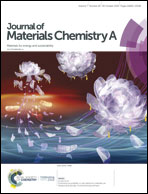Tetraphenylethylene tethered phenothiazine-based double-anchored sensitizers for high performance dye-sensitized solar cells†
Abstract
Double-anchored phenothiazine-cored sensitizers (YL1–YL4) having a tetraphenylethylene (TPE) entity as the N-substituent with various π-spacers (thiophene, 3-hexylthiophene, 4-hexyl-2,2′-bithiophene, and 4-heptyl-4-hexyl-4H-cyclopenta[2,1-b:3,4-b′]dithiophene) are prepared for dye-sensitized solar cells (DSSCs). The YL4-based DSSC exhibits the best solar-to-electricity conversion efficiency of up to 9.79% and 10.87%, respectively, without and with the CDCA co-adsorbent. These values outperform the efficiencies of cells based on N719 (8.77%) and our previous outstanding double-anchored phenothiazine-cored dye (HL5, 8.53%). YL dyes possess double layered shelters for efficient blockade of dark current: the inner shelter from the dianchor skeleton and the outer shelter from clogged TPE units. Clogged TPEs also strengthen dye stability on the TiO2 surface. Under room light illumination (Philips T5 lamp), the YL4-based DSSC device exhibited high cell efficiencies of 27.54%, 26.81%, and 24.98% at 187 lux, 597 lux, and 1025 lux, respectively, showing great potential towards the Internet of Things (IoTs).



 Please wait while we load your content...
Please wait while we load your content...